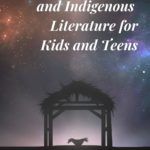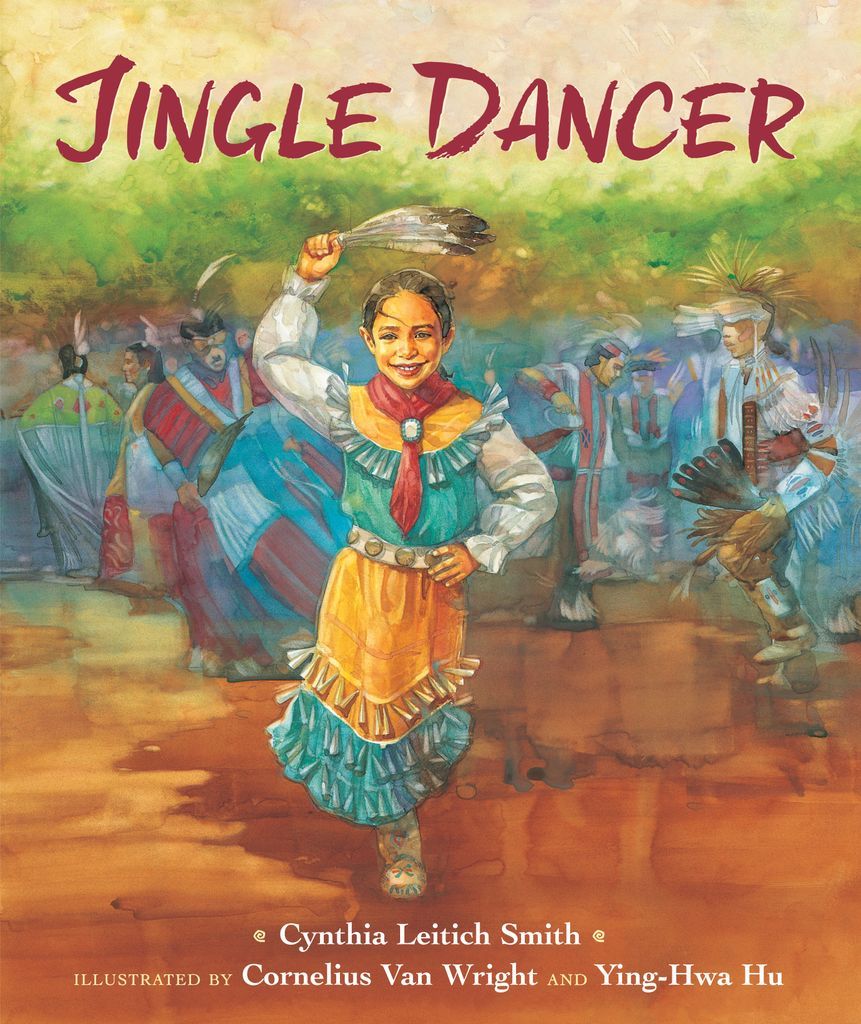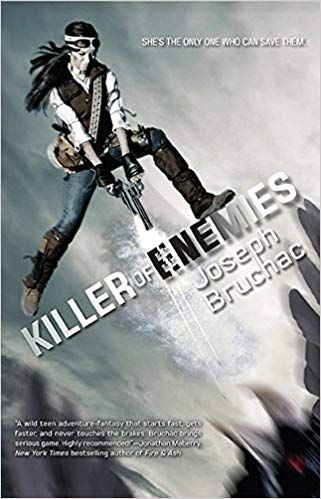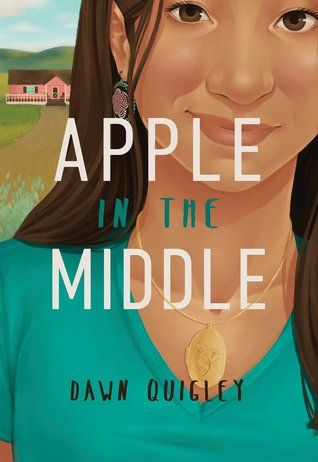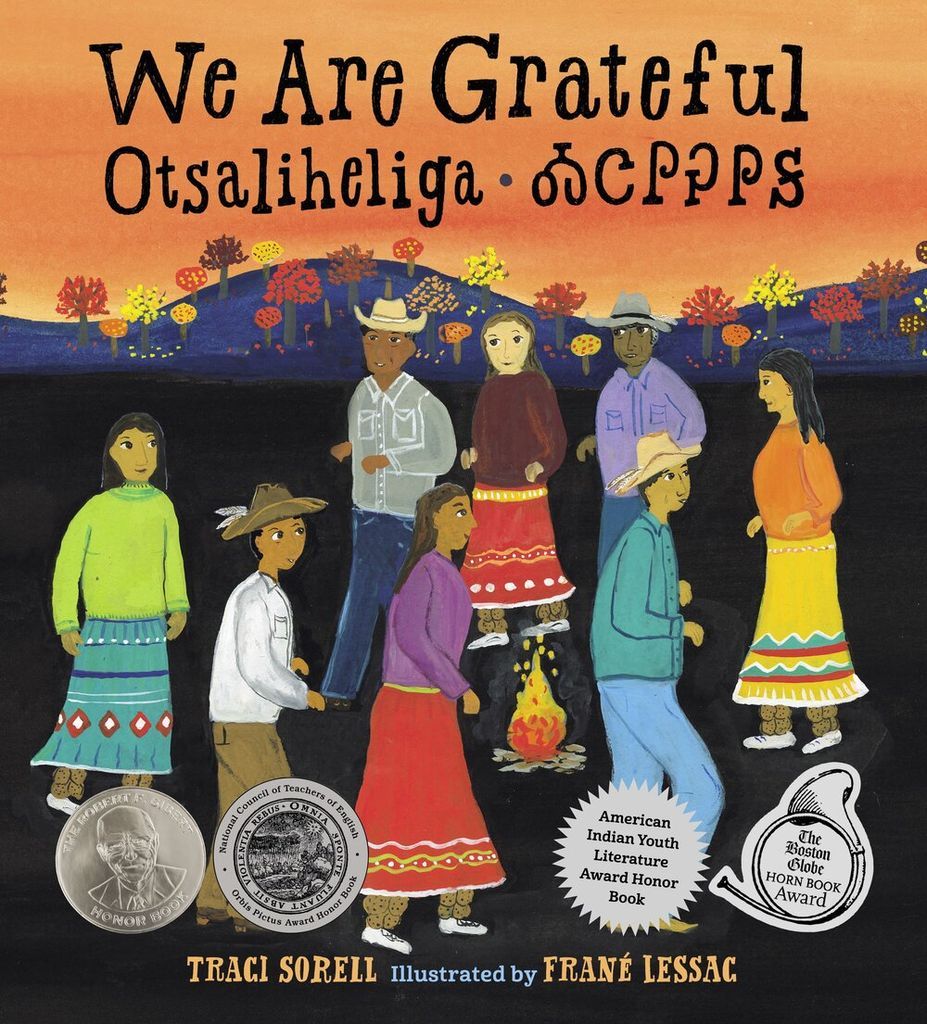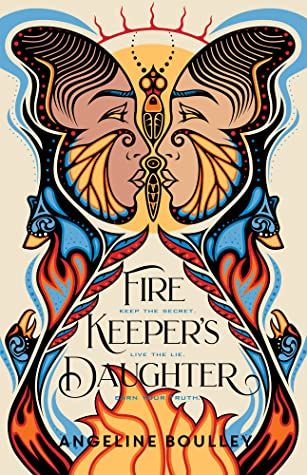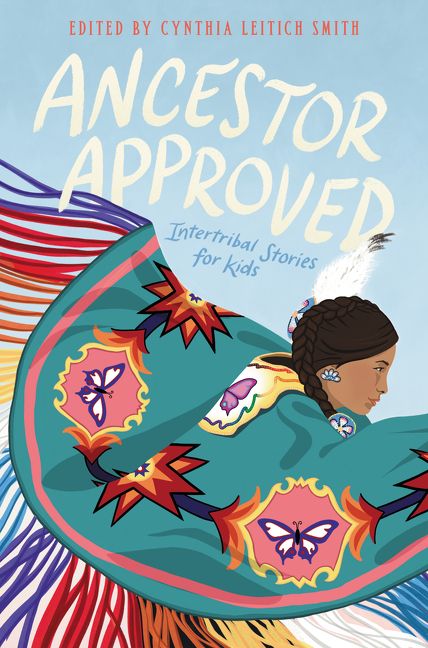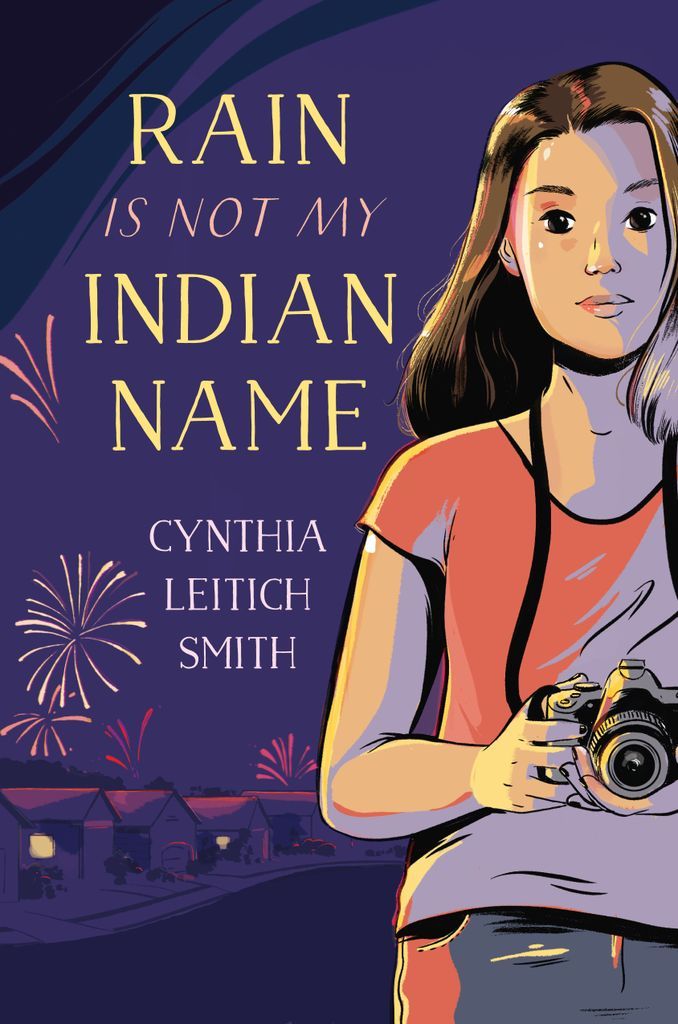Cynthia Leitich Smith (Muscogee Creek Nation) has been an advocate for Native children’s literature since the publication of her first book Jingle Dancer 20 years ago. She’s continued to champion on behalf of children’s literature broadly while furthering her passion for sharing Native stories for young people. “As a child, I tended to avoid books with covers that hinted at any Native related content, probably because of negative experiences with inaccurate or bigoted depictions across popular mainstream media. I clearly remember watching Disney’s Peter Pan at the local drive-in after having spent time with classmates in the little carnival ride area next to the concession stand. I remember being worried that my friends, who were also of course watching the movie, would think that the ‘Indians’ depicted on screen had anything to do with being Native,” she said. “Certainly, I heard stories told informally by Native elders, but I don’t recall finding a book authored by a Native person until I was in my 20s. I remember coming across Joe Bruchac’s Eagle Song and Heart of a Chief at Borders on Michigan Avenue and tearing up with surprise and a burst of optimism.” In Winter 2021—this coming January—Leitich Smith will launch the first books in her own imprint, Heartdrum, at HarperCollins. The imprint centers Native voices for young readers, with books ranging from picture books to YA novels that explore intertribal experiences. Heartdrum is the first imprint from a major publisher focused exclusively on Indigenous stories. Leitich Smith credits Ellen Oh, bestselling author and co-founder of We Need Diverse Books, as the inspiration for Heartdrum’s creation. “[She] first suggested establishing the imprint to me over breakfast at a conference, and I replied that someone more famous or fancy should do it,” said Leitich Smith. “Over time, though, I realized I needed to get out [of] everybody’s way, myself included. It wasn’t really about me. It was about what I could bring to fellow creatives in terms of encouragement and developmental feedback.” Inclusive storytelling is beyond a passing fad. Since the development of We Need Diverse Books in 2014, readers have continued to voice demand for diverse reading that showcase the multidimensionalities of the world. We’ve seen books by authors of color skyrocket to the top of The New York Times Best Seller list and remain there as fixtures; we’ve seen more voices of color being honored with some of the most well-revered awards in the industry; we’ve seen many of these stories go on to be adapted into beloved films; and we’ve seen the power these books have had in telling young readers they’re being seen and that their voices and experiences matter. It’s beyond time for Native voices to see their stories on shelves in ways that represent the myriad traditions, practices, and cultural experiences that make this diverse group so vast. “We’re in the midst of a determined movement to improve the industry mindset and landscape,” said Leitich Smith. “There are still influential people dismissing inclusion as a passing trend. I’m wary of that attitude—but Native people are no strangers to adversity. By working together in community, lifting one another up, we can not only survive but prosper in the world of books. That’s good news for young readers everywhere, especially Native kids.”
#OwnVoices
Created by YA author Corinne Duyvis in 2015, the #OwnVoices hashtag highlights books wherein the creator and main character (or secondary character) share an identity. “While the concept of ‘marginalized characters written by marginalized authors’ is in no way new, I think that having straightforward shorthand has made it easier to prioritize and centralize these books within the diversity discussion. It’s changed how we talk about representation, in both good and bad ways,” Duyvis said in a Publishers Weekly interview five years after its creation. “I’ve seen lots of marginalized authors feel emboldened by the popularity of the hashtag, saying it gave them the faith that people actually wanted to read the kind of novels they hoped to write.” For Native and Indigenous writers, #OwnVoices is vital in sharing authentic stories that don’t fall victim to tropes or stereotypes about Native people—but it’s also challenging. “I think the very existence of this hash tag makes it more likely that readers will be sensitive to the issue. No ‘ethnic group’ has been more stereotyped, misrepresented, and, quite frankly, used than Native Americans,” said Joseph Bruchac (Abenaki), longtime children’s and young adult author. Kim Rogers, author of books for children and teens and enrolled Wichita, notes that #OwnVoices allow for nuance and depth for readers with respectful and accurate portrayals of communities that have otherwise been written poorly by outsiders. “Identity issues are a common struggle, especially for those of us who did not grow up in our tribal communities or on a reservation,” she said. “Some of us wonder if we’re qualified to tell our own stories. It’s so frustrating when we question this while some non-Native writers continue to take our stories so flippantly without thought to the harm it causes us and readers.” “Wrestling with identity is a result of our ancestors being forced into Indian boarding schools where everything was stolen from them including our languages, clothing, and culture. They were taught to forget where they came from and to assimilate into white culture on our own stolen homelands. They were punished severely if they broke the rules. Those things are passed down and affect many of us to this day in the form of intergenerational trauma. Thankfully, we are healing and we have reclaimed much of what was lost—including our own voices. It’s a powerful form of resistance,” Rogers said. Brian Lee Young (Navajo) added that there’s additional weight in the challenge when it comes to talking about and promoting #OwnVoices stories like his forthcoming title, while #OwnVoices means the door is open for books like his to thrive. “With my culture, there are a lot of restrictions of what can and can’t be shared. Even those restrictions can be different from cultural participant to participant. So I hear from one person ‘you can’t talk about this’ and another person says ‘it’s okay to talk about this but this other thing is a big no.’ At the end of the day I can’t please everyone and I know that some people will be unhappy with how much I share,” he said. “And my struggle in depicting my own culture is what #OwnVoices is about. Because, even though this is my culture, it’s also my friend’s culture, it’s my community’s culture, it’s my nation’s culture.” Marginalized authors bear the weight of providing what scholar Rudine Sims Bishop calls “mirrors, windows, and sliding glass doors.” Their stories serve as a way for young people especially to see themselves, to be seen by others, and to offer a means by which to connect with one another. This is precisely why the #OwnVoices movement has had such a powerful impact and has created more space for the stories that are missing from shelves—and missing from the hands of readers who most deserve them. And for Native writers, already among the most marginalized and misrepresented, the weight is especially heavy, though the opportunities to step up continue to encourage more and more storytellers who may otherwise have not found their voices in traditional publishing. “I think readers are realizing their hunger for our stories. And I think they’re learning that most books with ‘Native themes,’ authored by non-Native folks, don’t always provide ‘mirrors’ for Native experiences. They’re often more like funhouse mirrors: misshapen, distorted, and weird,” said middle grade and young adult author Christine Day (Upper Skagit). “I think it’s important for literary gatekeepers to swap out those funhouse mirrors for the real ones, because fiction is so powerful in shaping how young people make sense of the world around them. We owe them better explanations of Native histories and circumstances. We owe them more diverse, truthful representations of Native people living in the contemporary world.” Lee Young believes that in addition to #OwnVoices being an open door, it’s also a challenge to do even better with representation. “#OwnVoices has been so important and continues to be important. But I think it needs to go further especially with regards the representation of native cultures and stories. I encourage the use of tribally specified voices such as #NavajoVoice to further emphasis that the writer aside from being of indigenous heritage is the heritage that the protagonist is,” he added.
Changes and Challenges of Writing Native Stories for Young Readers
The American public education system spends little, if any, time on Native history beyond the colonial, pioneering narratives or the challenging experiences Natives faced on the Trail of Tears. And even among some of the most beloved “classics” in children’s literature, little is offered in the realities of Native history or contemporary life. Beloved franchises like Little House on the Prairie become staples in young (white) readers’ lives, wherein Natives are depicted in vile, inhumane ways that further harm and misinformation about entire races and cultures of people. “Our biggest challenges include a mainstream lack of familiarity with Native literary traditions, a lack of mainstream appreciation for the complexity, diversity and nuances of Native life, and misconceptions and misrepresentations that persist in non-Native media and educational institutions,” said Leitich Smith. “We also have scant-to-no representation at every link of the industry chain that connects story to kids. No major trade house editors or art directors or literary agents or publicists, and so forth. Our books are largely reviewed by folks who have at best an outsider’s knowledge base and by default, still tend to favor stereotypical depictions.” It’s these stereotypes, as well as the poor depictions of Native lives by non-Natives in pop culture and beyond, which have hampered embracing one’s culture and subsequently, storytelling, for many Native writers. As a young person attending camp, author Dawn Quigley (Turtle Mountain Band of Ojibwe) was shamed for her love of Native stories, and that experience haunted her for decades to come. “To alleviate the feelings of being homesick I brought my favorite book. It was a Winter’s count tale, which is a traditional Lakota pictographic retelling of a battle or hunting story. This book was read over and over by me and my mother, yet I still found something new each time I read it—a phrase, a drawing, a lesson. After returning from camp dinner one night I opened the cabin door to find my bag had been riffled through and on the bunk were my cabin mates—one girl held my book and was, in a melodramatic voice, reading my book in a stereotypical ‘Injun talk’ voice. My bunkmates were holding their sides in laughter. I made excuses of why I brought the book, and hid it away for the rest of camp—along with my identity as a Native person for many years, when I walked in and about school settings. After I returned home from camp, I gave my treasured book away, and hid my Native identity for many of my school years. I wish I could remember what I did with this book,” she said. Quigley continued, “My camp experience motivated me when I became an adult. I came to realize that too many Native American schoolchildren must also hide from their identity while having to endure biased, racist, and stereotypical literature taught by too many teachers– even today. My own children have brought home books with phrases claiming, ‘…those dirty Indians…,’ ‘…the squaw brought him food…,’ and even false notions that ‘Indian people did not know how to tell time.’ Now I study how non-Native teachers can create a ripple effect to open minds and hearts to appreciate Native literature, so no child needs to be ashamed of seeing books which reflects themselves.” Mankato, Minnesota, Quigley’s hometown, was home to the largest execution in U.S. history, but despite 12 years in the public school system, she never learned about in the classroom or in any books. It was her parents who taught her about the December 1862 massacre of 38 Dakota men. “The town of Mankato did not want to recognize this fact. It wanted to sweep the history under the rug,” she said. “We must know and teach the history, language and culture of the original people, particularly by those who have the Native-lived experience. Educators must especially learn about Native America (past and present) in order to break the biased and problematic notions of Indigenous people.” For author Traci Sorell (Cherokee), who calls herself a “latecomer” to writing, her desire to publish stories came from studying picture books and seeing first-hand the lack of representation of her own people—and how her son deserved those stories, told by Cherokee people. “It prompted me to figure out how to write these stories because I knew other Cherokee families as well as educators and librarians must be having the same challenge. We’re still here and need to have our contemporary lives reflected in books,” she said. Her experience growing up was filled with storytelling, both within her family and in the community around her. “Besides growing up in a family that could always spin a good story, I loved hearing my third grade teacher (a fellow Cherokee Nation citizen) read Where the Red Fern Grows and Summer of the Monkeys to my class after lunchtime. Both books are written by Wilson Rawls, also a Cherokee Nation citizen,” she said. He was the only Native author she remembers reading as a young person. Every year in Tahlequah, Oklahoma—the tribal capital—there’s a Red Fern festival to celebrate Rawls and his work. Despite not reading a wide range of Native stories growing up, Sorell wasn’t confronted with some of the books that depict Natives in harmful ways. “I also didn’t read Paul Goble, Laura Ingalls Wilder, Scott O’Dell or other well-known authors who’ve penned inaccurate representations of Native people in books for young people. I’m so grateful for that!” Angeline Boulley (Chippewa), whose debut YA novel Firekeeper’s Daughter hits shelves next spring, didn’t see herself in the books she read growing up, and as a result, found herself determined over a decade ago to write the story she desperately wanted to read. Her love of reading was fostered by parents who took her to the library every week. “I loved mysteries and thrillers—Nancy Drew, The Hardy Boys, Shirley Jackson, and Lois Duncan. But it wasn’t until I was a senior in high school that I read a book with a Native protagonist!” she said. “None of the books I read growing up reflected my identity as an Ojibwe girl with a Native father and non-Native mother.” “To be seen as the hero in a story—and that what I knew about my culture and community might be my greatest strength—would have been a revelation to me!” said Boulley. “So about 11 years ago, I decided to write the ‘Indigenous Nancy Drew’ mystery/thriller that I had wished to read as a teen.”
Navigating The Industry While Native
The publishing industry is very white. Lee & Low found in their research that, as of 2015, 79% of those working in publishing identified as white, followed by a scant 7% Asian, 6% Latinx, 4% Black, and a staggeringly painful under 1% identifying as Native. Given the lack of education about Native history and contemporary Native life, it’s not surprising that a white industry has perpetuated tired stereotypes and problematic portrayals of Natives in books for young readers. Native authors experience this first hand. As Lee Young, a newcomer to the industry noted, feedback about his first book was particularly painful. “When getting feedback from Healer, there is still one comment that disturbs my mind. I was told that my main character needs braids and to wear a feather in his hair otherwise the audience wouldn’t know that my main character was native,” he said. “My main character of Healer, Nathan, has short hair, wears glasses, and play video games.” “[A]ll too often our editors and publishers do not speak the same language we do—both literally and figuratively,” said Bruchac. “A few years ago, Eric Gansworth and I were part of a conversation at the New York Public Library with our editors about problems non-Native editors sometimes face in understanding things we are talking about in our books and the time we, as Native writers, need to spend educating them. My terrific editor at Tu Books, Stacy Whitman, talked about how she could not understand the reference I made to ‘snagging’ in one of my novels. She thought I had misspelled ‘snogging’ and had wondered why I was using a British slang term for ‘making out’ until I explained it was a contemporary Pan-Indian term for trying to hook up.” Bruchac noted that it’s exciting when an editor wants to engage with that new knowledge, rather than change or challenge it. Sorell noted that she can’t name a single Native person at a Big 5 publisher, and despite the challenges of navigating an industry without leaders who share her heritage, she’s been pleased with how open and welcoming to these stories the people she’s worked with have been. “I spend a lot of time educating. Without Native people in their family or close circle of friends, and usually not having studied/read/been exposed to Native Nations after 1900 (given that’s when we generally disappear from school curriculum and texts), folks come with information and images from white mainstream movies, TV, and pop culture. A very limited and problematic place to be. That said, I haven’t worked with anyone yet who hasn’t listened, been willing to learn and to help make the work the best it can be. That’s comforting on many levels,” she said. And like anyone else who writes, Native authors struggle with the realities of modern life and finding the time to sit down to create. Balancing life with writing, as well as finding a community of like-minded, passionate, and writers that understand the unique challenges one can face navigating the publishing industry while Native, is one of the reasons Boulley cites for her debut taking 11 years to complete. Boulley took part in a 2018 writer’s retreat for Native creators, wherein she realized the power of finding fellow Native creators passionate about sharing their stories. “[I]t felt like we had known each other forever. They just understood what it was like to write about your community and the balance of what you should include and what needs to be left off the page. [The] Native kid lit community is so supportive of each other!” she said. Leitich Smith’s Heartdrum marks a huge step for Big 5 publishing: not only is Leitich Smith the face for an imprint that highlights Native voices, but she is deeply involved in the editorial process itself. She’s responsible for reading submissions, offering feedback on acquisitions, sends revision requests, and is able to offer insight in every step of the publishing process.
Early Leaders and Contemporary Writers to Know
While Leitich Smith’s Heartdrum is the first Native-focused imprint from a major publisher, it’s far from the first publisher of books by Native writers and/or focused on reaching Native readers. Native writers have published as long as any other group of writers, despite the vast swaths of volumes that may occupy libraries and bookstores. “When I was a young reader there were no books for people of my age by Native authors readily available. Or, for that matter, books for readers of any age. Yes, there has been a long tradition of writing by Native Americans in both English and Spanish—beginning with such books as The Florida Of The Inca (1605) by the Andean writer Garcilaso de la Vega, the son of a Conquistador and an Inca woman. But most of the books by Native American writers were either out of print or not in the local or school libraries when I was growing up in the 1940s and ’50s,” said Bruchac. “As my friend Geary Hobson pointed out over two decades ago, there had been periods when Native American writers were being published, followed by years of disinterest in the publishing world for anything other than as-told-to books such as Black Elk Speaks,” Bruchac added. “As a result, it was only on my own that I began in my early 20s to discover such books by Lakota and Dakota writers as Zitkala-Sa’s Old Indian Legends (1901), Charles Alexander Eastman’s My Indian Boyhood (1931) and Luther Standing Bear’s Stories Of the Sioux (1934)—all of which I would have loved to read as a kid.” He noted hearing several Native storytellers outside his family growing up as well. “Several Native authors have paved the way for us,” said Rogers. “Louise Erdrich’s The Birchbark House came out in 1999. The series is a great alternative to Little House on the Prairie. I wish I would have had Louise’s novels when I was a kid! And there’s Joseph Bruchac. He’s published 120 books for children and teens.” Christine Day feels excitement for this moment in Native literature for young people and what’s about to come. “I think more publishers are acquiring stories from Native writers. I think more literary gatekeepers—teachers, librarians, and booksellers—are seeking out #OwnVoices titles. And I think more readers are realizing just how hungry they are for our stories. This shift is so important, because it will hopefully lead to more diverse Native writers rising throughout this industry,” she said, adding that Ancestor Approved: Intertribal Stories for Kids, a middle grade anthology set to publish in February 2021, is one she’s particularly excited for both as a contributor and as one to share with young readers. “[W]e all wrote intersecting short stories and poetry set at the Dance for Mother Earth Powwow at the University of Michigan. I think it’s safe to say that this book is a huge passion project for all of us. I can’t wait for folks to read it. This collection showcases diverse Native perspectives, and a staggering amount of talent.” Sorell, in her work studying picture books, notes that the last few years have seen a positive shift in the books published featuring Native main characters. This includes both #OwnVoices stories and the growth of Native authors and illustrators for children and those who may not be Native but who are doing the work and the research to move away from harmful stereotypes and depictions. Likewise, the breadth of stories is noteworthy. “First, there are a growing number of stories beyond the traditional stories being shared. That’s critical. Native Nations and their citizens need to be seen across nonfiction and fiction for all ages—birth to age 18. While there are still problematic books published about Native people for children and teens each year, they usually get attention for their shortcomings, which helps minimize their presence in classrooms and libraries,” said Sorell. “On the flip side, more stories demonstrating the creators have done the work necessary to share culturally accurate representations of Native people are being published every year. That makes me incredibly happy. I want our young people and their peers to have a wide range of choices in nonfiction and fiction to read and enjoy. Connected to that, the number of Native authors and illustrators creating those works is growing. This delights me every day!” Bruchac sees the contemporary landscape for Native and Indigenous writers optimistically, too, thanks in part to the tremendous force of those passionate about these books and stories. What was once relegated to the one or two books to represent such a vast experience, with loads of inaccurate books about Natives by non-Natives, is changing. “It was smaller publishers, such as Fulcrum Books, who truly led the way by both publishing Native authors and doing a great job of selling those books. And astute literary critics—such as Debbie Reese—kept pounding away at that wall,” he said. “The result is that today we have more authentic Native voices appearing in print than at any time before this in history, so many of them that I am constantly seeing new names appear in print. There are people in that new generation of writers—such as Traci Sorell—doing incredible work of providing information and encouraging other authors. Plus, and this brings a big smile to my face, Cynthia Leitich Smith now has her own imprint for Native kid lit—Heartdrum.” Leitich Smith feels blessed to have found her way into publishing during the early ’00s alongside other Native writers like Shonto Begay, Joseph Bruchac, Floyd Cooper, Louise Erdrich, and Michael Lacapa, and she looks forward to welcoming more newcomers to Native children’s literature, including Michaela Goade, Kevin Noble Maillard, Traci Sorell, as well as YA author Angeline Boulley and picture book writer Patricia Buckley. “We’re in the midst of a determined movement to improve the industry mindset and landscape. While the need for more quality books remains pressing, we remain grateful for those early, influential voices/visions who persisted, those who joined them along the way, and we’re also welcoming a rising wave of exciting newcomers,” she said.
Finding Native Books for Children and Teens
It’s been primarily small, independent, and academic presses publishing Natives stories. With the launch of Heartdrum, as more readers seek out Native stories, finding those books can be a bit tricky.
Heartdrum’s first titles will launch this winter and include Christine Day’s sophomore novel The Sea in Winter. Day is one of the contributors to another book on Heartdrum’s initial list, Ancestor Approved: Intertribal Stories for Kids, an anthology edited by Leitich Smith set during the Dance for Mother Earth Powwow in Ann Arbor, Michigan. The collection includes contributions from Eric Gansworth, Kim Rogers, Tim Tingle, Monique Gray Smith, and more.
“The concept is that the stories (and many of the characters) intersect at the two-day event. It was a highly collaborative project, co-written through an online message board, emails, texts and phone calls,” Leitich Smith said.
Three of Leitich Smith’s earlier works will be repackaged and republished as well, including Jingle Dancer, Indian Shoes, and Rain Is Not My Indian Name.
“That initial list will be a bit of a springboard as we’ve acquired quite a few upcoming titles, which are now in various stages of revision and production, notably including Jo Jo Makoons: The Used to Be Best Friend by Dawn Quigley, illustrated by Tara Audibert, which will launch a humorous and adorable chapter book series, and Healer of the Water Monster by debut novelist Brian Young with a cover by famed artist Shonto Begay,” she said.
Readers itching to dive deeper will do well exploring the catalogs of publishers such as Charlesbridge, Kokila/Penguin, Lee & Low, Levine Querido, Native Realities, 7th Generation/Native Voices, Reycraft Books, and Salina Bookshelf.
Leitich Smith also says to look for tribally published books like Anthony Perry’s Chula The Fox from White Dog/Chickasaw Press; small-press titles like Bowwow Powwow: Bagosenjige-niimi’idim by Brenda J. Child, translated by Gordon Jourdain, and illustrated by Jonathan Thunder from Minnesota Historical Society Press; and university-press releases like Johnny’s Pheasant by Cheryl Minnema, illustrated by Julie Flett.
She also encourages readers to explore the lists at Pemmican Publications and Inhabit Media.
And of course, as the United States and Canada are both settler nations, it’s vital to remember that Native and Indigenous literature are not only not a monolith, but they’re not relegated to a single modern country or experience. There is a world of Native and Indigenous children’s book set across the globe.
“Many wonderful books have been written by our First Nations friends in Canada. Those that come to mind are The Marrow Thieves, a young adult novel published in 2017 written by Cherie Dimaline, and anything by the talented author/illustrator Julie Flett. I love her latest picture book, Birdsong, published in 2019. Don’t miss books by Monique Gray Smith, Richard Van Camp, Jenny Kay Dupuis, and David Alexander Robertson,” offered Rogers.
Boulley offered a powerful array of favorites, too.
“I love The Marrow Thieves by Cherie Dimaline. The Night Wanderer (about an Anishinaabe vampire) by Drew Hayden Taylor was originally published in 2007 and then released as a graphic novel in 2013. Strangers by David A. Robertson is another good one, as is Son of a Trickster by Eden Robinson, which is now also a Canadian television series (YAY!!!) called Trickster,” she said.
Leitich Smith notes that she’s surprised to be unable to name a single current Native Hawaiian children’s author but is excited to pick up Malulani Moreno’s debut An Island Without You (2021). She also recommends the work of Ambelin Kwaymullina from the Palyku people of Australia.
Readers will find much to enjoy perusing the American Indian Youth Literature award winners, as well as the lists curated by Leitich Smith herself.
“One thing that we all must do is advocate and search for Native-authored books. Look at great websites like Cynthia Leitich Smith, or the American Indian Library Association, but also to seek to understand who is writing a Native book. Start asking: is this person connected to a specific tribal community?” said Quigley. “Explore these sites, seek recommendations because there are so many Native books out there!”
The future of Native children’s literature glows bright—and it’s on us as readers to continue to read these stories, share these stories, and advocate for even more richness to this tapestry of lived experiences.
